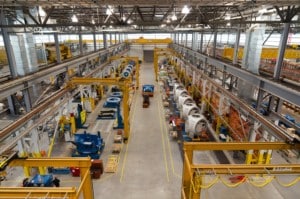Air Caster technology requires a proper seal to the floor to create an air film. Our Air Casters are constructed from 100% urethane, which is more pliable than nylon or hybrid materials used by other air caster manufacturers, allowing our air casters to function on more flooring surfaces. Our Air Casters are designed and tested to the flooring specifications below. Compliance with these flooring requirements will ensure that your air caster system operates
Air Caster Flooring
Surface Texture is the most important factor when evaluating your floor. Air Casters float on approximately a millimeter thin film of air which requires a smooth surface. We recommend your concrete floor be machine trowel finished or smoother. Heavily textured floors, such as broom finished concrete, or porous floor materials are incompatible with air casters.
Floor Slope is also an important factor to consider. Air Casters will drift with the declines in the floor, while increased moving force is required on inclines in the floor. For manually operated equipment, we recommend that the floor not exceed a slope of .2% in any 10-foot run (a total of ¼ inch rise in any 10 feet). For power-driven or assisted equipment, we recommend that the floor not exceed a slope of .4% in any 10-foot run (a total of ½ inch rise in any 10 feet).
If your facility has less-than-ideal floors, there are simple, low-cost fixes available for most surfaces.
Cracks and seams in your floor are another important consideration. Similarly, expansion joints are often wide and recessed enough to allow much air to escape. They too should be filled or covered. Excessive cracks in the floor can cause air seal issues, similar to expansion joints, and may also need to be filled.
Floor Projections such as anchor bolts, or cover plates should be finished flush with the floor surface. Blind holes with a diameter of less than approximately 10% of the caster diameter will work with air casters.
If your floor has imperfections, air caster equipment can still be a viable option. Many flooring issues can be resolved to make your floor compliant for air caster use.
Air Bearing Floor Obstacles
Bridges or Ramps can be used to transition from one surface to another or navigate over obstacles. Typically only light gauge sheet metal is needed to bridge seams, cover floor grating, or a ramp to differing floor materials. These need to be longer than the air caster, and we recommend that a very slight break be placed two inches on both sides of the sheet metal to keep the edges in contact with the floor.
Sheet Material Overlays are a solution for rigging moves, as they are the most cost-effective way to achieve floor compliance over rough or porous floor surfaces. The most common materials used for overlays are sheet steel or plastic. The overlay material thickness should not exceed 1/32″ to easy transition on to the overlay. When thicker overlay materials are required, they may necessitate the use of a ramp, which can be created by breaking the edge of the overlay material or by taping the leading edge with a thinner material. Please consult with our engineering team when considering using an overlay.














